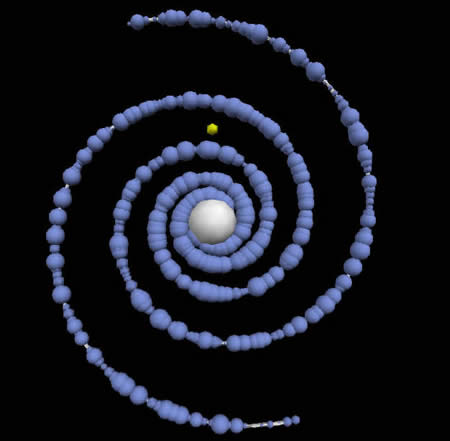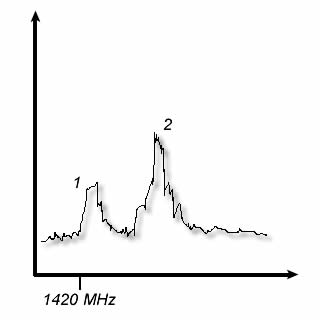Spiral Arms and Star Formation
330-334
The graceful arms of a spiral galaxy are enthralling and intriguing. Figure 12.16 is a stunning Hubble Space Telescope image of the nearby galaxy M51 and provides a complete "photo-essay" on spiral galaxies including our own Milky Way. Spend a few moments exploring the image - what patterns or features do you see?
| Figure 12.16 Interactive image of M51 - the great "Whirlpool Nebula". You can zoom in either by using the slider on the bottom of the image or by clicking the mouse. Pan the image by dragging the mouse or using the arrow keys. (Image from Hubble Space Telescope used with acknowledgement of STScI.) |
Seeing the "Forest Despite the Trees"
You may be familiar with the expression "can't see the forest for the trees". This simply means that sometimes, when in the middle of something (the trees), you can't see the "big picture" (the forest). Figure 12.17 is stunning image of the central part of the Milky Way. The picture was taken with a digital camera and a wide angle lens from the Cerro Tololo Observatory (Chile). This is what we can "see" - we are embedded in the galactic plane (ie - surrounded by the "trees"). Trying to get the big picture of the spiral structure ("the forest") is not easy.
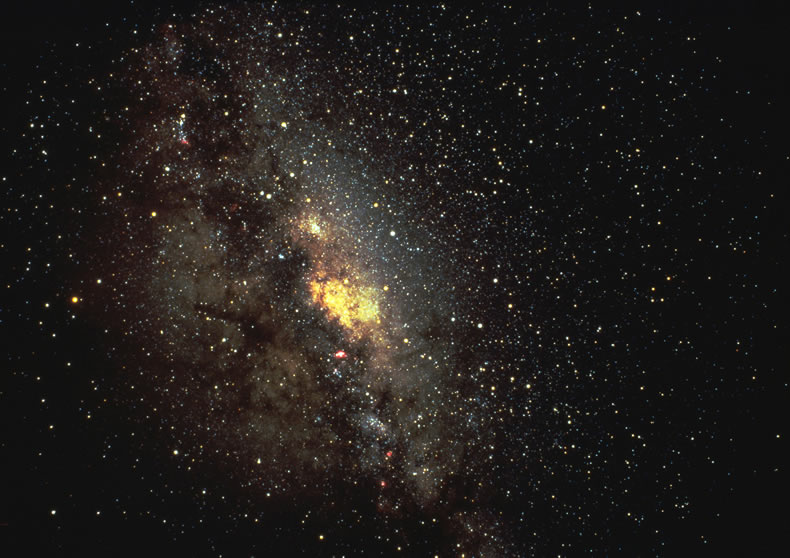 |
| Figure 12.17 The Milky Way looking in the direction of Sagittarius. Image courtesy of NOAO and Cerro Tololo Observatories. |
Tracing Spiral Arms
There are many spiral tracers that delineate the spiral arms in our own galaxy and in other spiral galaxies.
OB Associations
One of the most striking aspects of Figure 12.16 are the bright red regions that trace the spiral arms in M51. These are regions of vigorous star birth. Zoom in on one of these regions and inspect the image carefully.
Example 12.9 What features can you see in Figure 12.16 that would lead you to suspect that the spiral arms are regions in which star formation is occurring?
Solution: There are at least three good clues that these are star forming regions. First - the bright red areas are consistent with hot clouds of Hydrogen gas - heated by the presence of hot new stars. Second, there are many intricately patterned dark lanes - dust from which stars formed. Finally, there are many bright bluish coloured stars - again consistent with the idea that stars have recently formed.
One of the most conspicuous spiral tracers are the numerous bright OB associations that delineate the arms. OB associations are regions rich in O and B type stars. Because these stars are very luminous they can be seen at great distances and help make the spiral arms very bright. One of the ideas that we will develop is that whatever creates the spiral arms also creates OB associations. To understand this consider the following example:
Example 12.10 How far would you expect an O star to move in a spiral arm during its lifetime?
Solution: Recall from Chapter 12.1 that typical orbital speeds on the galaxy are about 230 km/s for regions away from the galactic centre. Also, in Unit 4 you learned that O stars are very short lived - ( a 30 Mo star "lives" about 2 million years). Combining these you can reason that moving at 230 km/s for 2 million years the O star could only travel:
![]() . To carry out this calculation convert years into seconds (1 year = 31.6 million seconds!) so write:
. To carry out this calculation convert years into seconds (1 year = 31.6 million seconds!) so write:

Since 1 pc = 3.86 X 1016 m
![]()
This is considerably less than the width of a spiral arm and helps strengthen the claim that the formation of these stars coincides with the formation of the spiral arm.
Open Clusters
Other spiral tracers include young open clusters. Figure 12.18 shows a video clip using data produced with the Digital Universe (see Take a Closer Look below for more information). The cyan coloured dots represent the positions of the known open clusters in our galaxy while the blue dots are known OB associations. The bright white area is shows stars in the vicinity of our Sun.
| Figure 12.18 |
These are all confined to the galactic plane (blue coloured grid) and the youngest open clusters are closest to the spiral arms. A faint image of a spiral galaxy appears as a background - this is what astronomers think the Milky Way might look like to an extra-galactic observer.

"Tuning in on the Galaxy" - Observing the Milky Way with Radio Waves
We live in the spiral arm region of our galaxy. As you can easily see by looking at the image of M51 in Figure 12.16, spiral arms are dusty places and, because visible light is readily absorbed by dust, visible light alone would give us a partial picture of what the spiral arms in our own galaxy look like. To see through this obscuring dust we can use longer wavelengths - infrared, microwave and long radio wave.
"Listening" to Hydrogen in the Galaxy
One of the most useful radio regions is in the microwave at a wavelength of 21 cm. This is radiation produced by cold, atomic hydrogen atoms. Cold hydrogen atoms are usually in their lowest energy states - that is the electron is in the ground or n = 1 state. However, there is a subtle way in which even in the n=1 state a Hydrogen atom can emit energy. This happens because both the electron and proton in the atoms have magnetic fields and a property called spin. In a hydrogen atom the electron and proton spins can either align with each other or be opposite directions. If the spins of both the proton and electron are aligned then the atom is in a very weak excited state. It can go to a lower energy level if the spin state of the electron "flips". For this reason the transition is called a spin-flip transition and when the electron does this a 21 cm wavelength photon is emitted. The applet shown in Figure 12.19 illustrates this for you.
| Figure 12.19 |
Hydrogen is a very useful spiral-arm tracer gas. Figure 12.20 shows a top down view of our galaxy. In this figure the blue "blobs" represent clouds of Hydrogen gas. The yellow circle represents the Sun at a position between spiral arms. The diagonal line is your line of sight in a particular direction in which you can detect several different clouds on separate spiral arms.
The galaxy does not rotate as a solid body. Because stars and gas in the outer regions of the galaxy have much farther to travel than material closer to the nucleus they will rotate at a lower angular speed around the galaxy.This is called differential rotation and we can exploit this to help detect separate spiral arms in the galaxy. To help understand this inspect Figure 12.20 which is a rollover image. When you move the mouse over the image it splits into red and blue quadrants. The blue areas represent regions in which the Sun is approaching more distant clouds of hydrogen gas (or they are catching up on the Sun). This means that they appear to be approaching the Sun and their 21 cm signals will be Doppler shifted to the blue (frequency increases). The red quadrants represent the opposite - the distance between the Sun and the hydrogen clouds appears to be increasing. The more distant of the two clouds (#2) has the greater blue-shift in this example. By carefully noting how many distinct Doppler-shifted signals you receive in any given direction you can begin to detect separate spiral arms and map the spiral structure of the galaxy.
Example 12.11 You are traveling east and a police car is following you! How will the police officer's radar be Doppler shifted (red or blue) in the following scenarios:
a)you are moving with a speed of 50 km/s and the officer is moving with a speed of 60 km/s
b)you are moving with a speed of 70 km/s and the officer is moving with a speed of 60 km/s
c) you are both moving with a speed of 60 km/s
Solution: In scenario a) the police car will be catching up with you - it is approaching you so the radar will be blue-shifted. In scenario b) the opposite occurs - you are pulling away from the police car and the radar signal is red-shifted. In scenario c) the separation between the two of you does not change - there is no Doppler shift.
The "Big Picture"
In addition to OB associations, open clusters and cold Hydrogen there are many other tracers than can be used to help give us a picture of how the Milky Way might appear to a distant observer. Figure 12.21 shows an artist's conception of the Milky Way based upon the most current data. One thing to note (and which be discussed in more detail later) is the bar-like appearance of the nucleus. We think that the Milky Way is a barred spiral galaxy. If you move the mouse over Figure 12.21 you will see the names assigned to the spiral arms. Of special note is where we are - the "Orion Spur". This looks like a piece of spiral arm that has broken away.
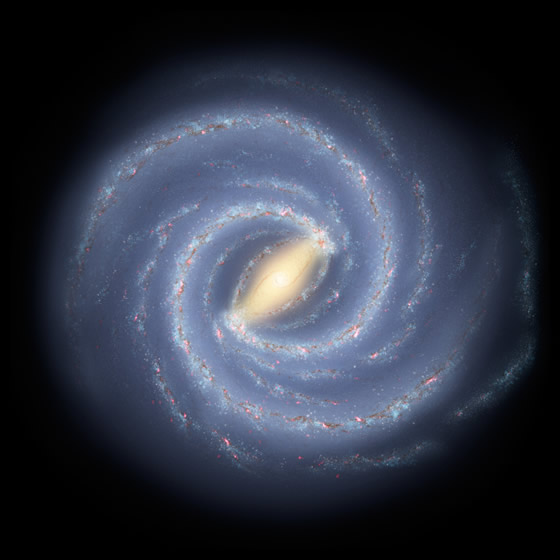 |
| Figure 12.21 Artist's reconstruction of how the Milky Way galaxy would appear to a distant observer. (image credit: NASA/JPL-Caltech ) |
Spiral Arms - What They are and How They Form
How do spiral arms form? Why are there "jagged" or broken parts of arms (the Orion Spur for example)? Our understanding spiral structure is still far from complete but there are a number of ideas that have gain consensus in the astronomical world.
What Spiral Arms Are NOT - The Winding Dilemma
Spiral arms are not spiral-shaped structures that rotate around the galaxy! Differential rotation in the galaxy would quickly "wrap" the spiral arms around the nucleus. This is called the "Winding Dilemma" because it is clear that the spiral patterns that we see in galaxies must b long lived. To illustrate this problem spend a few moments experimenting with the applet spiralArm provided in Figure 12.22.
| The "age" in millions of years is shown in the lower left corner. Even after less than one galactic year or the time it takes the Sun to travel around the galaxy (about 250 million years) - differential rotation destroys the spiral pattern in the galaxy. | |
| Figure 12.22 |
The Spiral Density Wave Theory
A generally accepted
mechanism for producing the spiral structure is called the density wave which
is thought to be a disturbance that gently travels around the galaxy compressing
gas in its wake. This is illustrated in Figure 12.23.
Galactic rotation is faster than the spiral density wave so it is a combination of matter rotating into the wave, compressing and then passing through. This compressing gas triggers star formation and helps explain why we see the concentration of bright young stars and clusters in the spiral arms. As the density waves sweeps through a region of the galaxy it leaves in its wake newly formed stars that will blend, over time, into the disk population. The spiral density wave theory seems to be a very good one with one glaring problem - we don't really understand how the spiral density wave gets started in the first place! There are several good competing theories explaining the origin of the density wave:
- gravitational interactions between neighbouring galaxies might be able to trigger the spiral density waves
- asymmetric mass distributions in the center of the rotating galaxy could generate the required density wave
| Figure 12.23 A spiral density wave slowly rotating and possibly compressing gas and triggering star formation. In the case of a galaxy like M101 (shown here) the rotation of the galaxy (CCW) also plays an important part. The view is from a frame that is rotating with the galaxy. In the spiral-density wave theory, it is the rotation of the galaxy that drives matter into the more slowly rotating spiral wave. Thus, from the frame rotating with the galaxy it appears as if there is a spiral density wave rotating CW. The formation and stability of the spiral wave is still a mystery and source of debate! |
Another problem with the density wave model is how to explain the branches and spurs often seen in spiral arms. There is evidence to suggest that the Sun is located in such a spur. Figure 12.24 shows an example of this in the galaxy M51.
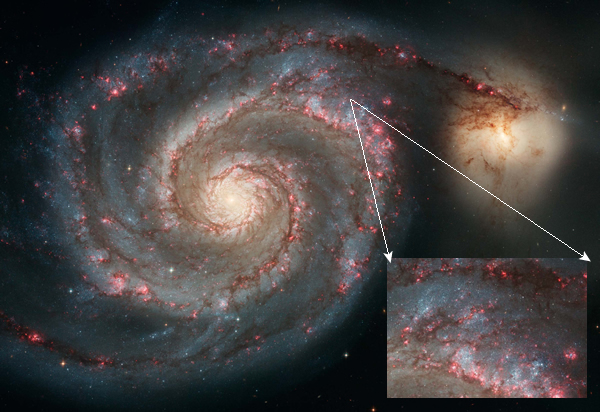 |
| Figure 12.24 Inset image is a close up of a spur in one of the spiral arms in M51. |
An Alternate Theory of Spiral Structure Formation: Self -Sustaining Star Formation
The spiral density wave theory is not the only one. Another possible explanation is the Self -Sustaining Star Formation theory. In this theory massive episodes of star birth are triggered in a galaxy either via supernovae, shock waves from the stellar winds of massive stars or gravitational interaction. The differential rotation of the galaxy also enters in so that the inner parts of the star forming region pull ahead of the outer parts and the entire region is stretched into spiral-like filaments. This theory also more successfully explains how flocculent galaxies could arise.Which of these two theories is correct? Only more observations and improved computer modeling of galaxies will resolve this intriguing question. It is very likely that both are correct and each plays a part in either the formation or evolution of spiral structure.
Practice
- What is a spiral tracer? Give 3 examples.
- Why is an O-star a better spiral tracer than an M- star? (Give two reasons - one should be fairly obvious, for the other take a look at Example 12.10).
- Explain how observations of cold Hydrogen clouds can reveal the presence of more than one spiral arm.
- Explain why the presence of hot young stars on the edges of spiral arms supports the density wave theory for spiral structure.

To understand what spiral arms are, how they formed and how they are related to star formation.
Chp 15.3





